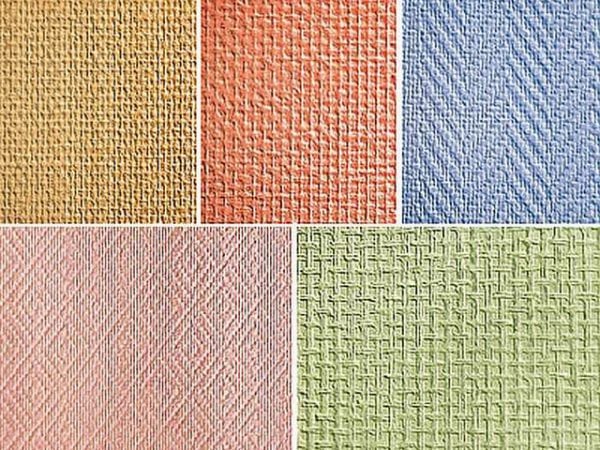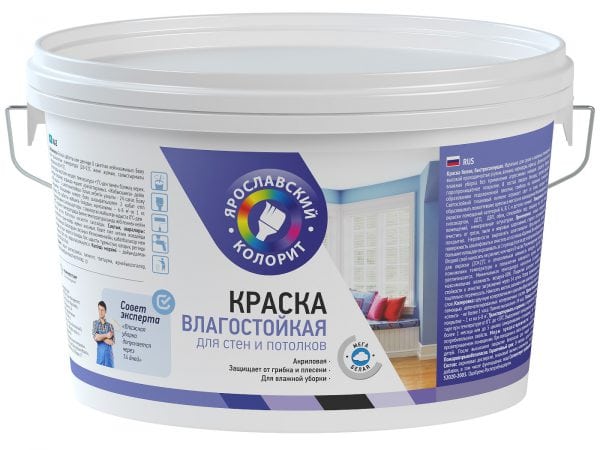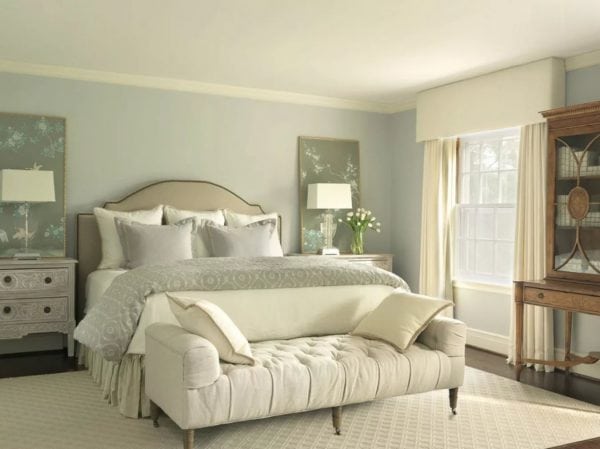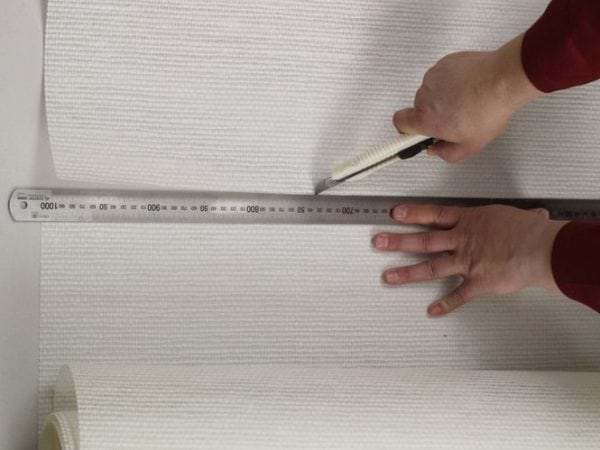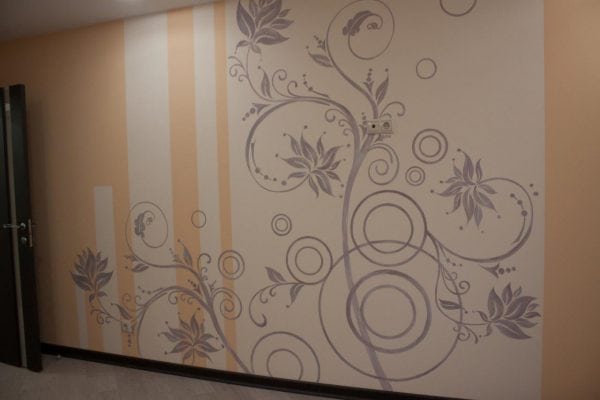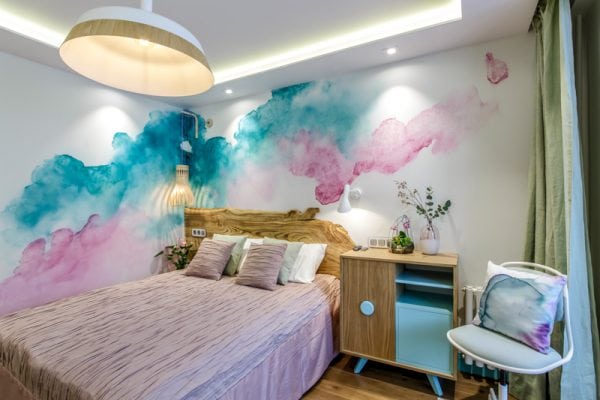Cullets are considered a very convenient material for beginners. Even if mistakes are made when pasting wallpapers, the material's features make them easy to eliminate. The fact is that on the textured coating, the fit of the joints will not be visible at all. You can finally get rid of defects that arose due to the inexperience of the master at the staining stage.
- Glass Wallpaper Features
- Paint selection
- Types of waterborne paints
- Manufacturers
- Color selection
- Sticking
- Painting
- Borders
- Stencils
- Dyeing
- Azure staining
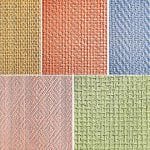
Painting glass is also a simple process. Nevertheless, as in any business, wallpapering and painting have their own nuances.
Glass Wallpaper Features
Cullets are a modern material with many advantages:
- Cullets are made from a high-strength base. The material will be preserved even in case of attacks on it by domestic animals. This wallpaper is generally very resistant to mechanical damage.
- The material is highly resistant to fire.
- The surface of the cullet is resistant to dust and dirt, since the material contains an antistatic agent.
- Thanks to the antiseptic preparation, the wallpaper is protected from the formation of fungus and mold on them.
- The composition of the final material includes specialized glass fabrics, which are characterized by resistance to wear. In addition, the fabrics are made from natural materials, which is good from the point of view of environmental friendliness and safety.
- Wallpaper of this type looks very respectable. There is a wide variety of textures, colors, and patterns.
It is advisable to repaint glasspieces periodically, therefore it is recommended to purchase material with a deep relief. In this case, the new paint will not overlap the old. In the presence of a deep relief, the original texture will remain even after repeated staining.
to contents ↑Paint selection
Paint for cullet should be water-dispersible - as most experts believe. Water-dispersed compositions correspond to the following parameters:
- quick drying;
- lack of an unpleasant smell;
- quick and deep impregnation of the material;
- non toxicity.
Since the composition of water-dispersed paints and varnishes includes a synthetic polymer substance, a film forms on the surface. This film acts as a buffer that protects the material from negative external influences.
to contents ↑Types of waterborne paints
There are three groups of water dispersion compounds:
- Butadiene-styrene dispersion. This type of paint is highly resistant to moisture. However, these paints and varnishes have a significant drawback - instability to ultraviolet. Over time, surfaces painted with styrene-butadiene dispersions fade very much, so they try to use such paints in rooms with windows on the north side.
- Polyvinyl acetate paints and varnishes. Paints of this type are favorably distinguished by low prices. Polyvinyl acetate is not characterized by high water resistance, so its scope is dry rooms.
- Acrylic compounds. This type of paintwork is characterized by maximum water resistance. Acrylic also tolerates ultraviolet radiation.Another advantage of acrylic is its quick drying. Acrylic paints are considered the best choice for painting fiberglass wallpaper.
to contents ↑Note! If you need additional protection against fire, you can purchase a special fire-resistant acrylic paint.
Manufacturers
The decision about what kind of paint to paint cullet, is largely dictated by a positive attitude towards a particular manufacturer. For example, the well-known Finnish company Tikkurila is considered a manufacturer of very high-quality paints that have proven themselves for many decades.
Not so well-known to the general consumer, but the quality of products of the German company "Meffert", which produces paint for fiberglass wallpaper "Mattlatex Dufa", has not worse quality.
As an example, these types of paints for fiberglass wallpaper:
- "Tikkurila Harmony." This paintwork material is of high quality, quick drying and moderate consumption. "Tikkurila Harmony" lacks a pungent odor, is offered in a wide range of colors and at very affordable prices. The Tikkurila company also produces matte paint, with which you can give the surface a velvety surface.
- "Tikkurila Euro 2". Paint is made from acrylate copolymer with inclusion in the composition of latex. An opaque palette is also available. The company recommends using paint only for painting dry rooms.
- Mattlatex Dufa A paint and varnish composition from a German company is characterized by high resistance to external influences and economical consumption. Mattlatex Dufa contains latex and the surface is matte.
Color selection
When a manufacturer is selected, you can think about choosing the right shade of paint. Most often, personal taste is crucial in this matter. However, when choosing, it is recommended not to forget about some practical considerations:
- Bright eye-catching colors can look attractive, but the mood will change sooner or later, and flashy shades can be very annoying. In addition, too bright colors usually quickly bother.
- If you still want to make bright accents, it is recommended to use inserts with your favorite colors on a background of pastel colors.
- According to the rules of good taste, the color of the walls should be combined with the colors of furniture and other large interior items.
- Small drawings can change the geometric perception of the room, and large elements are suitable for rooms with a large area.
to contents ↑Advice! In small premises, the use of several colors makes it possible to visually increase the room.
Sticking
First of all, fiberglass wallpaper for painting needs to be glued to the wall. Below is a step-by-step instruction that will help to avoid mistakes during the gluing process:
- The optimum temperature in the room during the application of wallpaper on the wall is from 18 to 25 degrees heat. Relative humidity should not exceed 70%. If you neglect these conditions, the glue will dry unevenly. In addition, drafts and direct sunlight should be avoided, as otherwise the surface will bubble.
- For gluing cullets for painting, you need not some, but a special glue. PVA glue or any other formulations where one of the components is PVA is not suitable. The fact is that when using PVA glue with glass wallpaper, ugly yellow spots and stains will inevitably remain on the coating.
- Glue can be purchased both in finished and in powder form. Adhesive consumption per square meter is usually indicated on the packaging.
- Before gluing cullets for painting, we prepare the surface. We clear the wall of the old coating. The surface should be perfectly flat, so we putty it and clean it first with coarse-grained and then fine-grained sandpaper. Next, the surface is treated with acrylic primer for indoor use. We proceed to gluing the wallpaper only after the final drying of the surface.
- If we are talking about wallpaper with a simple pattern, first cut off a piece of canvas of a suitable size.The dimensions should correspond to the height of the room plus a 10-centimeter allowance to fit the pattern. Apply glue to one and a half canvases in a uniform layer. We glue the first canvas and at the same time use a plumb line so that the canvas is strictly vertical. We smooth the canvas along the wall (from the center towards the edges) using a plastic spatula. The glue protruding at the edges of the sheet is removed with a knife or spatula. We glue the following cloths butt to already glued.
- If it comes to wallpapering with a complex pattern, then you need to act a little differently. First, we cut the canvas, taking into account the rapport (the distance between the repeating elements of the picture). Do not forget to leave 10-12 centimeters to fit the canvas. We number the chopped pieces (on the reverse side). The report is always indicated on the product label. The indicator should be taken into account when the number of cullets per room is planned.
- With wallpaper with a complex pattern, you can do something else: abandon the manufacture of blanks and immediately do the gluing. In this case, the canvas is adjusted to the drawing along the way. The rest of the gluing of glass with a complex pattern does not differ from gluing simple wallpapers.
Before painting the cullet with a pre-selected paint, it is necessary to wait until the glue has completely dried on the surface.
to contents ↑Painting
Before applying paint, it is recommended that you read the instructions on the packaging. The instructions indicate the consumption of paint and varnish material, drying time and other useful information.
Wallpaper is recommended to be primed with a roller. Without a primer, the surface will have insufficient adhesive properties (adhesion of dissimilar materials), and the texture of the material will not be expressed as it could.
We apply the paintwork material on the relief glass using a spray gun or a roller. The brush will not provide the same uniform distribution of paint on the surface. The coloring matter is applied in two layers. The second layer is applied 12 hours after the first.
DIY glass painting can be done in several ways:
- with the use of borders;
- using stencils;
- doctoring method;
- using azure.
to contents ↑
Borders
When working with borders should be borne in mind:
- One textured pattern based on fiberglass is used both at the top and bottom of the curb.
- Various textured solutions for the border may be used in the composition.
When all the paintings are already on the wall, glue the border. In order for the work to be done correctly, we mark the wall in advance. The border is applied only to a completely dried wall.
Stencils
Using a stencil involves not just painting the surface, but creating geometric patterns. First, we carry out the main painting of the canvas. After that, with the help of masking tape we put the planned patterns on the surface of the glass. At the same time, we apply the drawing very carefully, using a foam sponge. It is very important to avoid leakage of paint material under the adhesive tape.
When the paint is completely dry, carefully remove the masking tape from the wall. The dried surface of the finished drawing can also be treated with paint - this time by hand.
to contents ↑Dyeing
This method is quite simple to execute. For the main color, deep and rich tones are suitable. After the first layer has dried, we apply a less toning glaze coating. For this purpose, decorative water-based varnish (translucent) or some other paint and varnish material with the metallic effect is suitable.
Without waiting for the coating to dry, we remove the excess dye with a moistened foam sponge. The goal is to leave the paint only in the textured recesses of the relief coating.
to contents ↑Advice! Squeegee staining can also be done with a spatula (rubber or plastic).
Azure staining
First, apply a coat of paint using a roller or spray gun. When the surface dries, proceed to the application of azure. Use a flat brush for this. The nature of the movements is transverse, in small strokes. After about 20 minutes, we smear the composition on the wallpaper with a rubber spatula. Thanks to the spatula, it is possible to achieve an even distribution of flakes on the surface.
If you want to get a more saturated color, we repeat the work done earlier again or use a slightly different tone from the original one to give the surface a visual depth.

